The Evolution from MMA to Azure Arc
Before diving into Azure Arc, it's important to understand the journey that brought us here. For years, I worked extensively with the Microsoft Monitoring Agent (MMA) architecture, and honestly, it was beautifully simple and effective.
→ Learn how we complete what Microsoft started
The Golden Age of MMA and Solution Packs
The old architecture was elegant in its simplicity. You had one agent - the Microsoft Monitoring Agent - and everything was enabled through solution packs at the Log Analytics workspace level. Azure Update Management was free, making it an easy door-opener to introduce other datacenter management capabilities to customers.
This architecture integrated seamlessly: Azure Automation, Process Automation, Configuration Management, Update Management, Inventory and Change Tracking, Log Analytics, Defender for Cloud (then Security Center), and Azure Sentinel all worked together as a unified ecosystem. One agent, multiple solution packs, everything connected to a central workspace. It was the best combo ever in terms of simplicity and integration.
The Service Evolution: V1 to V2 to V3
What many people don't realize is that the services we loved in the MMA era are now deprecated. Azure Update Management, Change Tracking, and Desired State Configuration - what I call the "V1 services" - were all based on Log Analytics Workspace (LAW) integrations and are no longer supported.
Microsoft has replaced them with entirely new architectures:
- Azure Update Management → Azure Update Manager (V2)
- Change Tracking (solution pack) → Change Tracking via DCR (V2) → Change Tracking V3 (latest, but I haven't had time to test this newest version yet)
- Desired State Configuration → Azure Machine Configuration service through Azure Policies (V2)
This versioning is based on my own classification system, not official Microsoft numbering, but it helps understand the evolution. Each generation has become more capable but also more complex to implement and manage.
Why the Transition to Arc is More Complex
Now, with Azure Arc for Servers, things have become significantly more complicated. While the new architecture offers much more flexibility and capability, it's lost some of that beautiful simplicity that made the MMA approach so appealing to customers and easy to implement.
Looking at the Azure Arc building blocks today, the complexity is immediately apparent. We now have Azure Policies, Azure Resource Graph, Azure Log Analytics, User-assigned Managed Identity, Data Collection Rules (DCR), Data Collection Endpoints (DCE), Azure Monitoring Agent, Extensions, and the core Azure Arc for Servers platform itself. Each component requires configuration, management, and understanding of how it interacts with the others.
The granular data collection capabilities through DCR and DCE let you precisely control what data gets collected from which servers and where it goes. You have DCR associations, different regional considerations, extension management, managed identities for authentication, and Azure Resource Graph for querying across your entire hybrid estate.
We've gained enormous capability, but the complexity has gone up exponentially. You need to understand management groups, subscriptions, Azure policies, RBAC inheritance, data collection architectures, extension lifecycles, and how all these components work together across different regions and compliance boundaries.
Some people dismiss the old approach as outdated and claim the new way is always better. I don't believe that's entirely true. The MMA architecture had real advantages in terms of simplicity and ease of deployment that we shouldn't ignore when planning Arc implementations.
What Azure Arc for Servers Actually Is
Azure Arc for Servers extends Azure management capabilities to machines running outside of Azure. At its core, it's a hybrid cloud platform that allows you to project on-premises servers, virtual machines from other cloud providers, and edge devices into Azure as first-class Azure resources.
When you Arc-enable a server, it becomes visible in the Azure portal alongside your native Azure VMs. You can apply Azure policies, install extensions, manage updates, collect logs, and even run PowerShell scripts remotely through the Azure Resource Manager (ARM) interface.
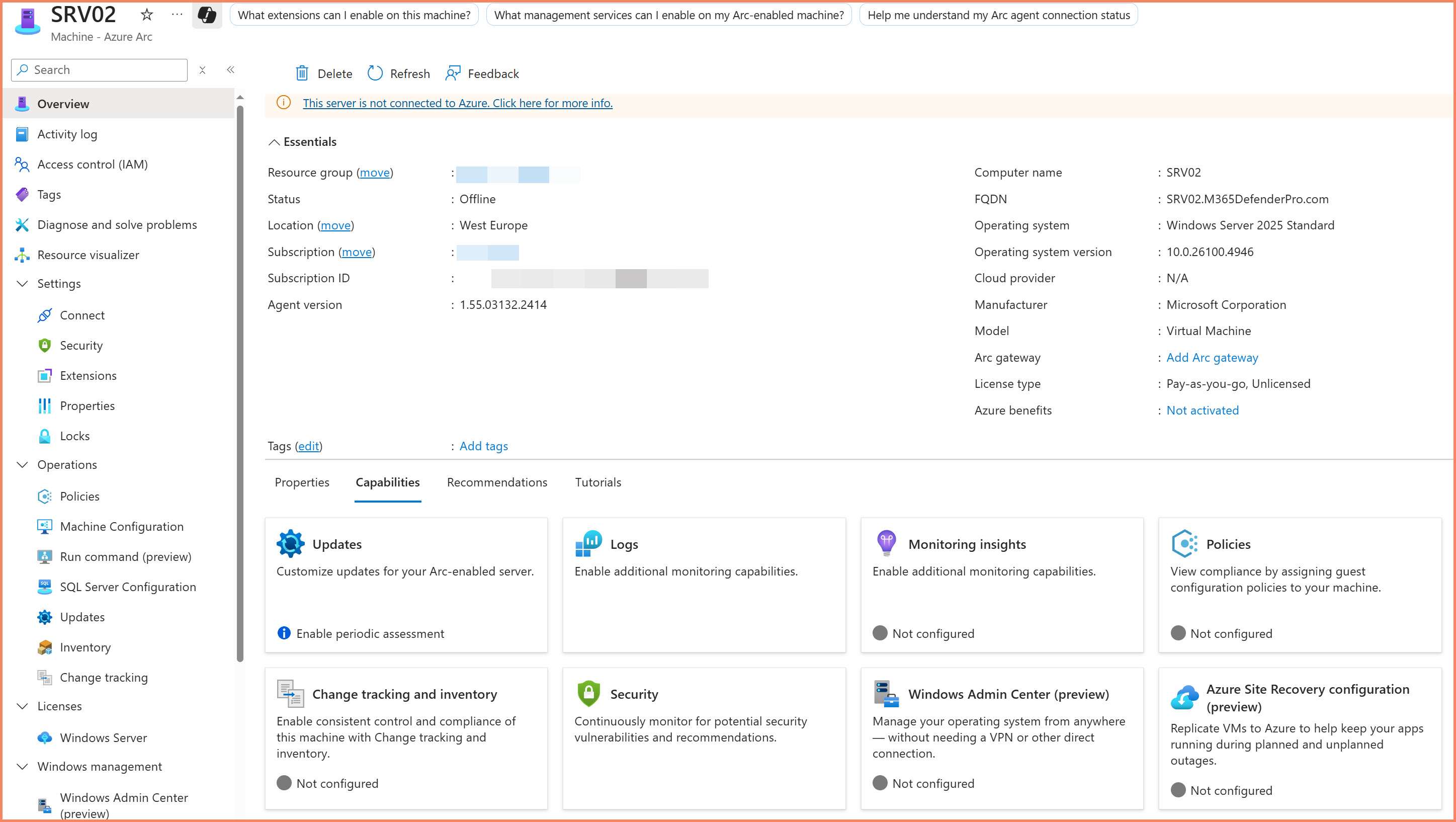
Azure Arc-enabled server appearing in Azure portal as a first-class Azure resource
Built on Azure Resource Manager (ARM)
The foundation of Azure Arc for Servers is Azure Resource Manager (ARM). When you onboard a server to Arc, it becomes a native Azure resource with a full ARM representation. This isn't just metadata storage - it's full integration with the Azure control plane.
This ARM foundation is what enables Arc servers to work with Azure RBAC, Azure Policy, resource tags, and all other Azure management capabilities. The server appears in the Azure portal, responds to ARM API calls, and can be managed through any Azure management tool.
- Native Azure management - Works with existing Azure tools and processes
- Resource organization - Fits into subscriptions, resource groups, and management hierarchies
- Policy enforcement - Azure Policy can govern Arc servers just like cloud VMs
- Access control - Azure RBAC controls who can manage Arc resources
- Automation compatibility - PowerShell, CLI, and REST APIs all work natively
This ARM foundation is why Arc feels like native Azure management rather than a separate hybrid management layer. Your on-premises servers become Azure resources that happen to be running elsewhere.
Business Case and Value Proposition
The fundamental business case for Azure Arc is platform unification - bringing your entire infrastructure and security stack under one management platform. Instead of juggling multiple tools for governance, protection, configuration, and monitoring, Arc creates a single Azure-based control plane for hybrid environments.
Azure Arc transforms fragmented hybrid management into a unified platform experience. Your governance policies, security protections, configuration management, and monitoring all operate through the same Azure control plane - whether resources are on-premises, in Azure, or other clouds.
Foundation for Hybrid-Cloud Management
Arc establishes the foundation that enables four critical management pillars across your entire infrastructure:
| Management Pillar | Traditional Approach | Arc Unified Approach |
|---|---|---|
| Governance | Separate tools for policy, compliance, RBAC | Azure Policy, Azure RBAC, compliance auditing |
| Protection | Multiple security vendors and agents | Microsoft Defender suite, centralized security |
| Configuration | SCCM, GPO, custom scripts | Azure Policy, Update Manager, Guest Configuration |
| Monitoring | SCOM, third-party monitoring tools | Azure Monitor, Log Analytics, Workbooks |
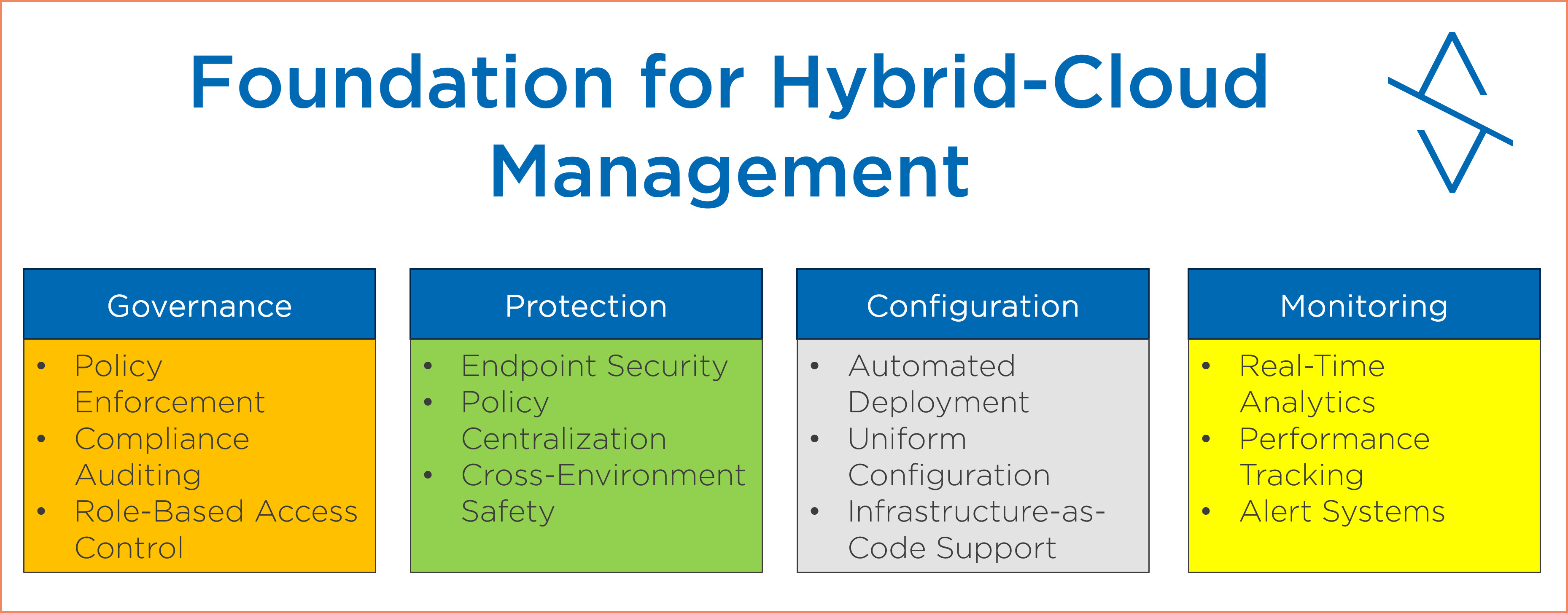
Arc foundation: Unified governance, protection, configuration, and monitoring across hybrid infrastructure
Business Impact: From Tool Sprawl to Platform Efficiency
Organizations typically manage hybrid infrastructure through 5-10 different management tools. Arc consolidates these into Azure's unified platform, delivering:
- Reduced operational complexity - One platform instead of multiple management tools
- Consistent security posture - Same protection mechanisms across all environments
- Unified reporting and compliance - Single dashboard for hybrid infrastructure state
- Streamlined automation - One API surface for all infrastructure management
- Skills consolidation - Azure expertise applies to entire infrastructure
Strategic Platform Foundation
Arc isn't just another management tool - it's the foundation that enables Azure's entire management ecosystem to work with your hybrid infrastructure. This includes Azure RBAC, Azure Policy, Defender for Cloud, Azure Monitor, and hundreds of other Azure services.
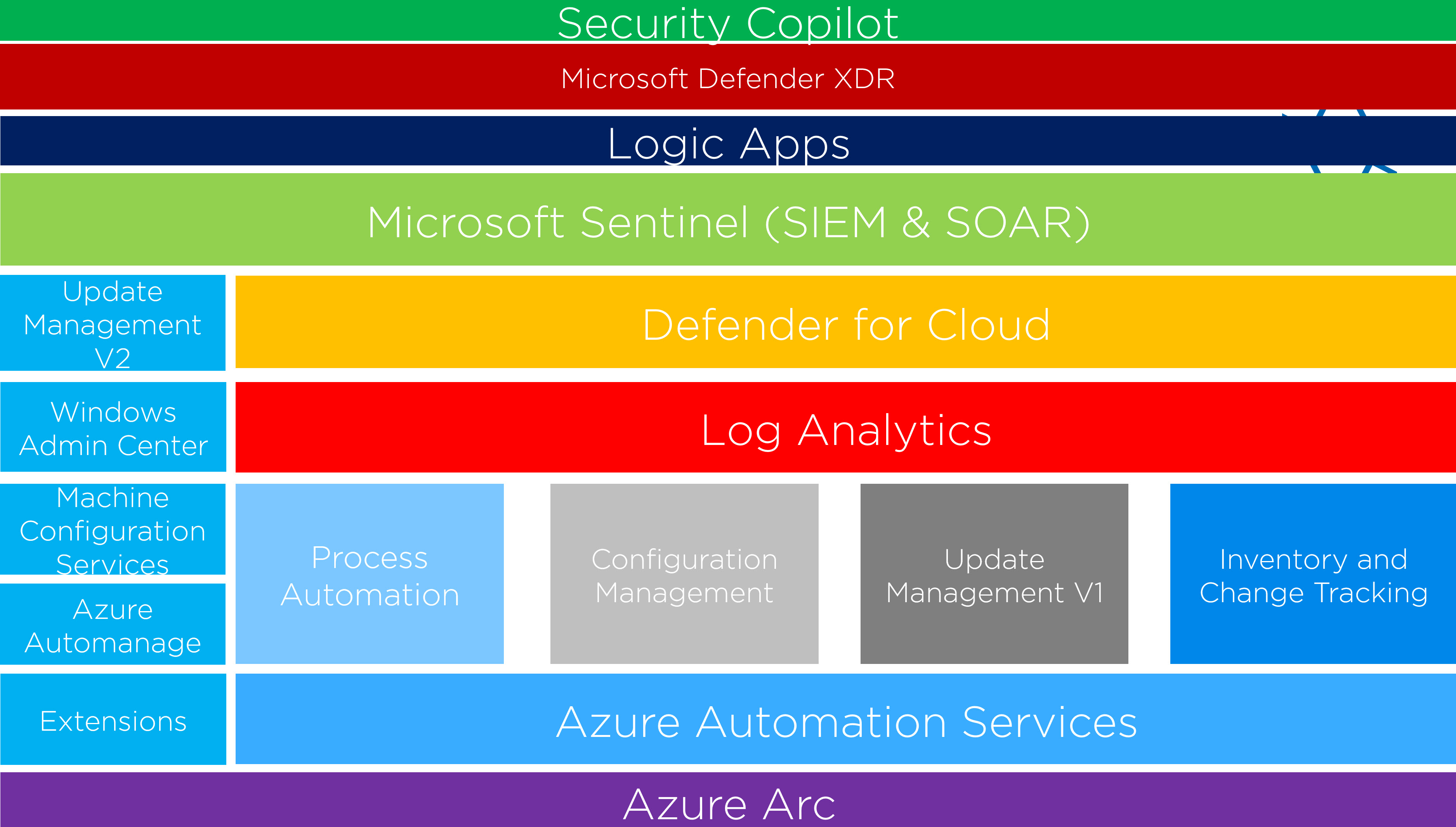
Arc ecosystem integration: Enabling Azure's entire service ecosystem for hybrid infrastructure management
Assessment Phase: Understanding Your Current State
Before implementing Azure Arc, you need to thoroughly assess your current infrastructure and administrative model. This isn't just an inventory exercise - it's about understanding the complexity and interdependencies that will impact your Arc deployment strategy.
Infrastructure Discovery and Classification
Start with a complete inventory of your server infrastructure. This goes beyond simple server counts - you need to understand operating systems, patch levels, network configurations, and existing management tools. Many organizations discover forgotten systems during this phase.
| Assessment Area | Key Questions | Arc Impact |
|---|---|---|
| Existing Management Tools | Configuration Manager, third-party tools, custom solutions | Migration path planning, feature gap analysis |
| Network Architecture | Proxy requirements, firewall rules, network segmentation | Connectivity method selection, security boundaries |
| Administrative Model | Current permissions, admin accounts, delegation model | Azure RBAC design, service principal strategy |
| Business Goals | Security improvements, operational efficiency, compliance | Extension selection, automation priorities |
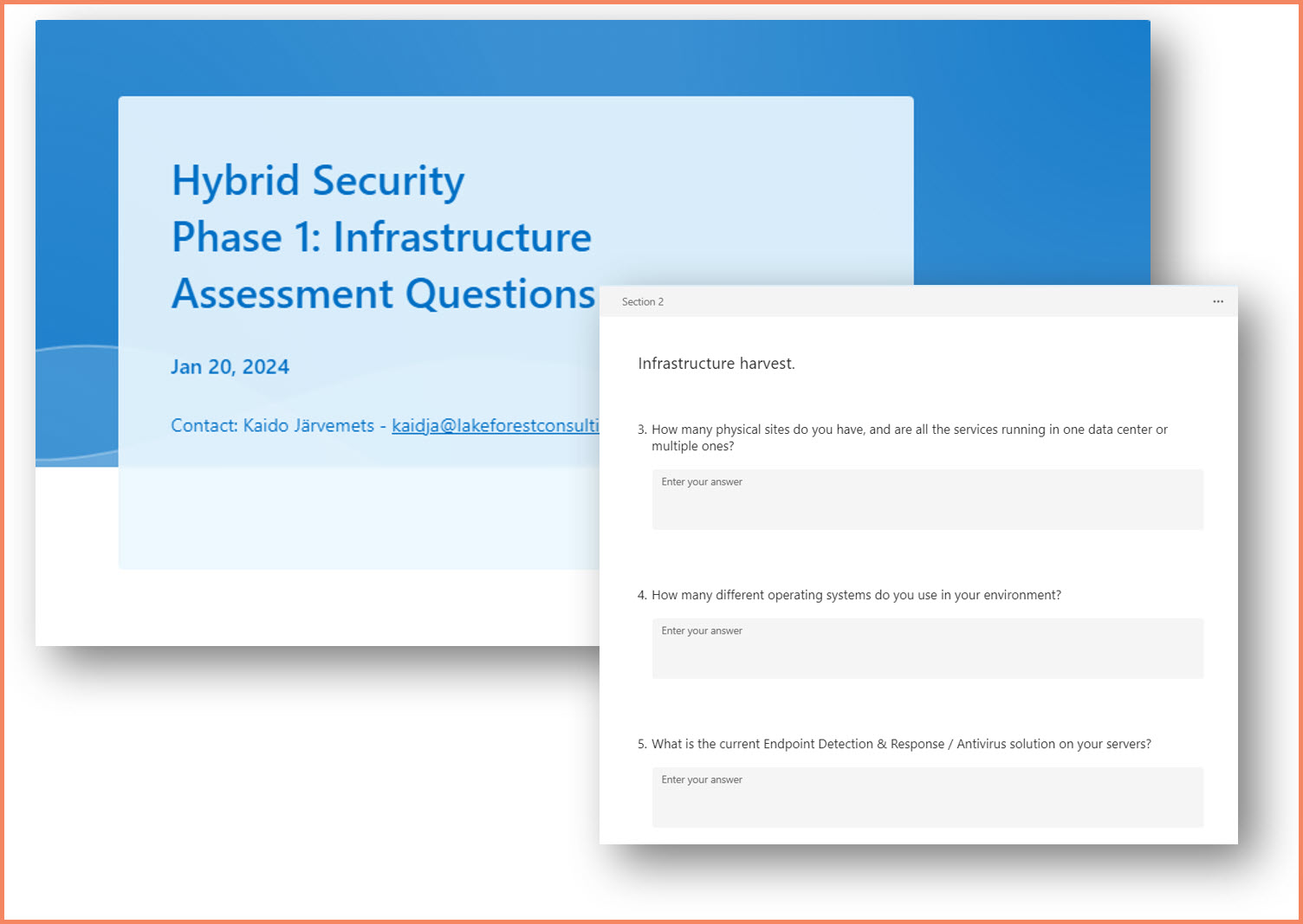
Arc assessment checklist: Infrastructure discovery, classification, and readiness evaluation
Legacy Tool Assessment
If you're currently using Configuration Manager (and yes, some of my MVP peers would want to slap me for calling it SCCM, but old habits die hard! 😄), understanding your existing collections, deployment packages, and automation scripts is critical. Arc doesn't simply replace Configuration Manager - it requires thoughtful migration of functionality.
Business Goal Alignment
Arc implementation should align with specific business objectives. Are you trying to improve security posture? Reduce operational overhead? Meet compliance requirements? The answers to these questions drive your Arc extension strategy and rollout approach.
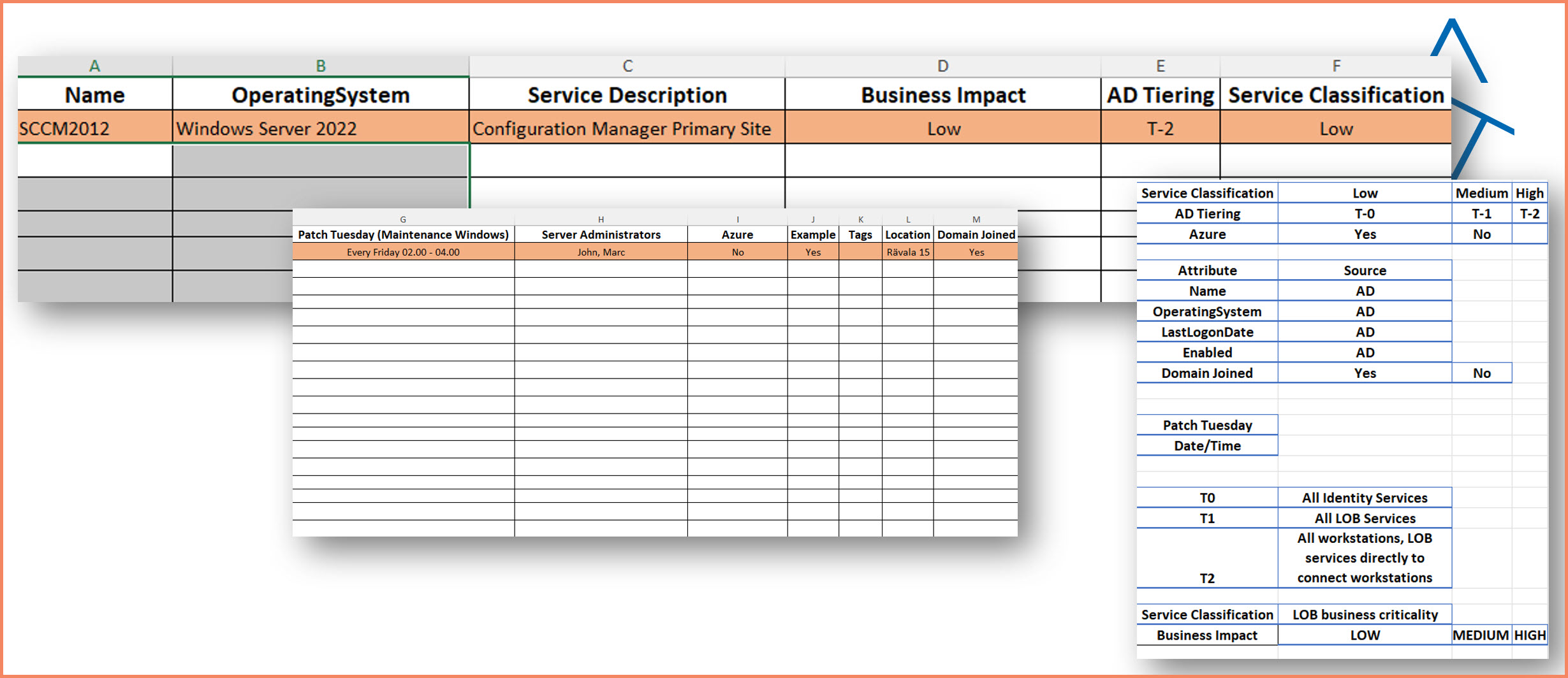
Arc server classification spreadsheet: Excel template showing server inventory with Tier 0/1/2 classification, applications, and current management tools
Design Workshops: Architecture Planning
Once you understand your current state, the design workshop phase focuses on creating the target architecture. This is where you make critical decisions about subscription structure, network connectivity, and administrative boundaries that will impact your Arc deployment for years to come.
Subscription and Resource Group Design
One of the most important architectural decisions is how to organize your Arc-enabled servers within Azure subscriptions and resource groups. This isn't just about organization - it directly impacts billing, permissions, and policy application.
| Design Aspect | Considerations | Best Practice |
|---|---|---|
| Subscription Strategy | Security tiers, billing boundaries, admin separation | Separate subscriptions for different security tiers |
| Resource Grouping | Geographic location, application ownership, lifecycle | Group by application or service rather than location |
| Naming Conventions | Consistency across hybrid environment, automation friendly | Include tier, location, and function in naming |
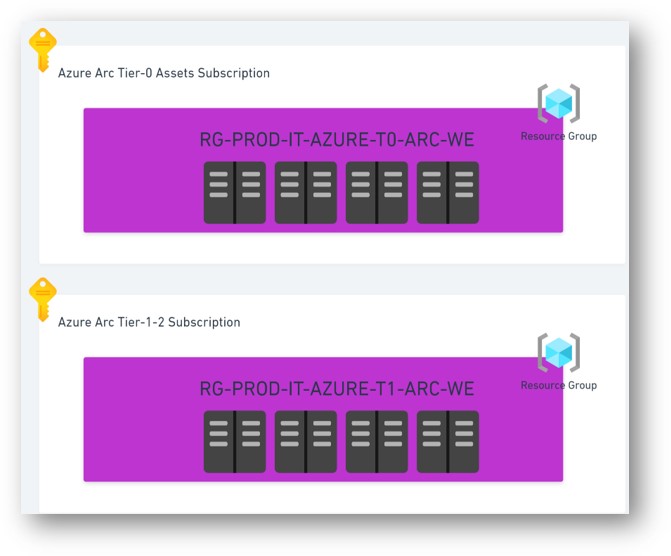
Arc subscription design: Security tier-based organization with clear RBAC boundaries and policy inheritance
Network Connectivity Architecture
Deciding how your Arc-enabled servers communicate with Azure is another critical architectural choice. The options range from direct internet connectivity to fully private connections using Arc Gateway or Azure Private Link.
| Connectivity Method | Use Case | Complexity | Security Level |
|---|---|---|---|
| Direct Internet | Small environments, initial testing | Low | Standard TLS encryption |
| Corporate Proxy | Existing proxy infrastructure | Medium | Corporate filtering + TLS |
| Arc Gateway | Segmented networks, reduced internet exposure | Medium | Centralized gateway control |
| Private Link | High security, no internet exposure | High | Private Azure backbone only |
Resource Tagging Strategy Design
During the design workshop phase, you need to carefully plan your resource tagging strategy. This isn't something to figure out later - tagging drives automation, policy application, cost allocation, and operational processes. Take time to understand what tags you actually need based on your business requirements.
Arc Tagging Considerations
Consider these categories during your design workshops, but only implement tags that serve a specific business or operational purpose:
| Tag Category | Purpose | Example Values |
|---|---|---|
| Security Tier | Microsoft Tier Model classification | Tier-0, Tier-1, Tier-2 |
| Patch Management | Update schedule targeting | Critical, Standard, Delayed |
| Business Ownership | Cost allocation and responsibility | Finance, HR, Engineering |
| Application Context | Service dependency mapping | Exchange, SharePoint, SQL |
| Maintenance Windows | Automated scheduling | Saturday-2AM, Sunday-3AM |
Remember: every tag you define needs governance, validation, and maintenance. Start with tags that drive automation or business requirements, then expand based on actual usage patterns.
Architecture Planning: Integration Strategy
The final planning phase defines how Arc integrates with your identity infrastructure and broader IT ecosystem. This phase establishes the security foundation through identity governance design, implements the Active Directory tiering model for proper asset classification, and plans the automation strategy that will drive operational efficiency. Getting this architecture right determines your security posture, operational success, and long-term Arc implementation outcomes.
Active Directory Tiering Model (Enterprise Access Model)
The traditional Active Directory tiering model (now evolved into Microsoft's "Enterprise Access Model") establishes proper security boundaries through administrative isolation. This architectural design must be integrated with your Arc subscription design, RBAC assignments, and operational processes:
| Tier Level | Assets | Arc Context | Security Impact |
|---|---|---|---|
| Tier 0 | Identity systems, domain controllers, Certificate Authorities | Arc management infrastructure, service principals | Highest - Controls all other tiers |
| Tier 1 | Application servers, data servers, file servers | Production Arc-enabled servers | High - Business critical workloads |
| Tier 2 | User workstations and devices | Arc-enabled workstations (if applicable) | Medium - User productivity impact |
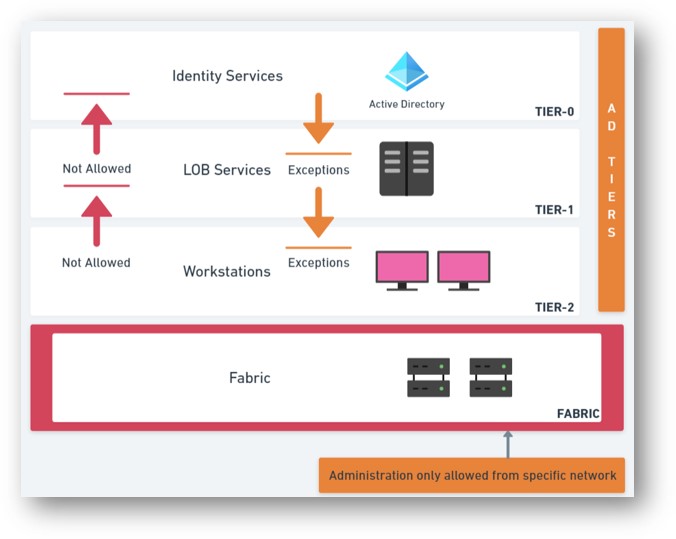
Active Directory tiering model: Tier 0/1/2 administrative boundaries and how they apply to Azure Arc server classification
- Separate subscriptions for each security tier to enforce administrative boundaries
- Dedicated service principals for Arc onboarding with tier-appropriate permissions
- Different regions for resources if geo-separation is required
- Automated classification using Azure Policy to tag servers by tier
Modern Identity Foundation for Hybrid Management
Before you can securely manage Arc servers and hybrid infrastructure, you need proper identity and access management as your foundation. You cannot secure other clouds with Azure without first securing the identity layer that controls access to everything.
Microsoft's Entra ID platform provides the modern identity security services that enable secure hybrid management:
- Cloud-only administrative accounts - Eliminate sync dependencies and on-premises compromise risks
- FIDO2 security keys - Passwordless authentication that can't be phished or compromised remotely
- Authentication Strengths - Granular control over authentication methods based on resource sensitivity
- Conditional Access policies - Context-aware access controls based on user, device, location, and risk
- Privileged Identity Management (PIM) - Just-in-time access with approval workflows and audit trails
- Identity Protection - AI-powered risk detection and automated remediation
- Access Reviews - Regular certification of permissions and access rights
Identity Governance Integration
With your identity security foundation established, you need to plan the technical implementation. Arc's integration with Entra ID creates specific governance requirements for how Arc service principals, Azure RBAC assignments, and conditional access policies work with your existing identity infrastructure.
| Identity Component | Arc Integration | Governance Requirements |
|---|---|---|
| Service Principals | Arc agent onboarding only | Credential rotation, permission reviews, minimal onboarding permissions |
| Azure RBAC | Access control for Arc resources and operations | Regular access reviews, principle of least privilege |
| Conditional Access | Protecting Azure portal access to Arc resources | MFA requirements, device compliance, location policies |
| PIM (Privileged Identity Management) | Just-in-time access for Arc administrative operations | Activation workflows, approval processes, audit trails |
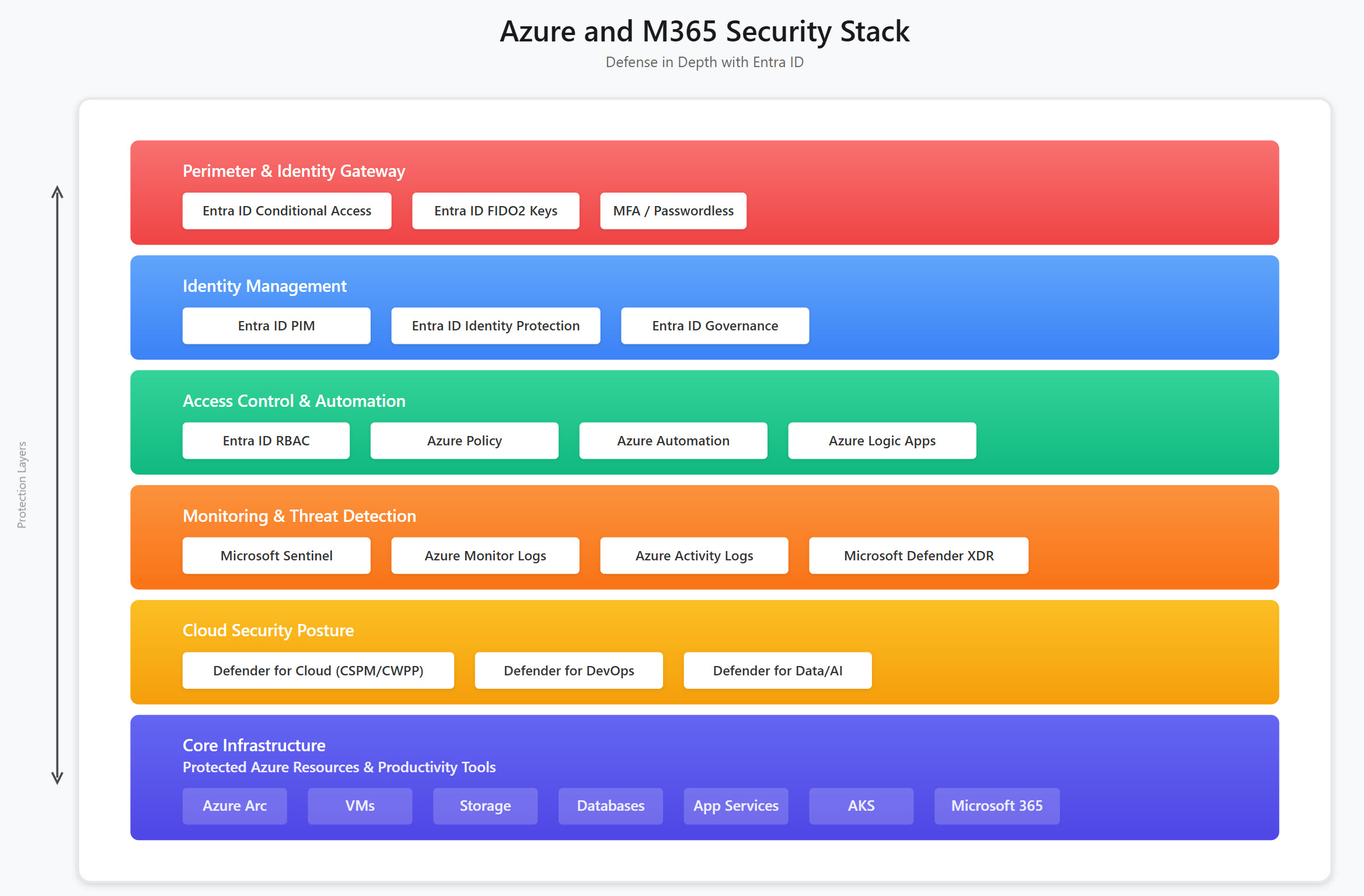
Arc identity governance architecture: Integration with Entra ID, Azure RBAC, Conditional Access, and PIM
Automation and Operations Strategy
The main automation foundation is Azure Automation Account + Hybrid Workers - this combination enables you to make automation across all clouds and on-premises infrastructure. Once you have hybrid workers deployed, you can connect to any data source you need: Entra ID, Defender XDR, CMDB, ServiceNow, custom APIs - you name it. This is where you deliver all the automation scenarios your business actually needs.
With this foundation established, you can build automation that includes patch management through Azure Update Manager, security configuration through Azure Policy, and custom automation through Azure Resource Graph queries - but the real power is connecting to all your data sources and systems.
Azure Resource Graph for Arc Automation
Azure Resource Graph serves as the foundation for everything you'll build on top of Arc automation. Think of it as a library that lists all your Azure resources, including Arc-enabled servers. This becomes necessary for automation scenarios, reporting, and workbooks.
Without understanding Resource Graph, you'll struggle with advanced Arc automation. Every PowerShell script, every workbook, every custom reporting solution you build will query Resource Graph to discover and work with your Arc-enabled machines.
Resources | where type == "microsoft.hybridcompute/machines" | extend AgentVersion = properties.agentVersion | extend LastHeartbeat = properties.lastStatusChange | project name, resourceGroup, location, AgentVersion, LastHeartbeat | order by name asc

Azure Resource Graph Explorer showing Arc-enabled servers with agent versions and status
Resource Tagging Strategy
Tagging becomes critical for Arc automation. Tags drive policy application, update schedules, and automation targeting. Your tagging strategy should align with your operational processes.
# Arc server tagging strategy implementation Environment = "Production" | "Development" | "Testing" Tier = "0" | "1" | "2" PatchGroup = "Critical" | "Standard" | "Delayed" Owner = "team-email@company.com" Application = "exchange" | "sharepoint" | "custom-app" MaintenanceWindow = "Saturday-2AM" | "Sunday-3AM" | "Wednesday-11PM"

Automated Defender integration tags: Azure automation runbook adds MDE exposure score, last seen timestamp, and onboarding status to every Arc server
Extension Deployment Planning
Extensions are the small applications that run on top of your Arc agent - they're what actually deliver functionality to your Arc-connected servers and Azure VMs. This is where the real business value emerges, but also where you'll encounter the most operational challenges.
What Extensions Actually Are
Extensions are lightweight applications that extend Arc agent functionality. They enable different capabilities on your servers:
- Microsoft Defender for Endpoint - Endpoint detection and response with Security Settings Management capabilities
- Azure Monitor Agent (AMA) - Log and metric collection
- Guest Configuration - Policy enforcement and compliance
- Custom Script Extensions - Run PowerShell or shell scripts
- Dependency Agent - Application dependency mapping
- Key Vault Extension - Certificate management
| Extension Category | Business Driver | Deployment Considerations |
|---|---|---|
| Security Extensions | Improve security posture, threat detection | Microsoft Defender for Endpoint, Defender for Cloud |
| Monitoring Extensions | Centralized monitoring, log aggregation | Azure Monitor Agent, custom log collection |
| Management Extensions | Patch management, configuration drift | Azure Update Manager, Guest Configuration |
| Custom Extensions | Specific business requirements | Application-specific agents, custom scripts |
Extension Monitoring and Lifecycle Management
The biggest mistake organizations make is deploying extensions through Azure Policy and assuming they're working. Policy assignment success doesn't equal functional extensions. You need active monitoring of extension health and actual functionality.
// Get all Arc machines with their extension status
resources
| where type =~ "microsoft.hybridcompute/machines"
| where properties.status == "Connected"
| project
MachineName = name,
ResourceGroup = resourceGroup,
Location = location,
OSType = properties.osType,
Status = properties.status,
AgentVersion = properties.agentVersion,
MachineId = tolower(id)
| join kind=leftouter (
resources
| where type =~ "microsoft.hybridcompute/machines/extensions"
| project
MachineId = tolower(tostring(split(id, "/extensions/")[0])),
ExtensionName = name,
ExtensionType = properties.type,
ProvisioningState = properties.provisioningState
) on MachineId
| project MachineName, ResourceGroup, ExtensionName, ExtensionType, ProvisioningState
| order by MachineName asc, ExtensionName asc
Common Extension Problems and Solutions
| Problem | Symptoms | Solution |
|---|---|---|
| Extension Stuck Installing | Shows "Installing" for hours | Remove extension, restart Arc agent, reinstall |
| Extension Shows Success but Not Working | Policy compliant but service not running | Check local service status, review extension logs |
| Extension Installation/Upgrade Stuck | Extension permanently stuck installing/upgrading, portal locked up | No PowerShell/API commands work. Two options: Nuke Arc object (lose everything) or contact support |
| Network Issues During Install | Extension fails with download errors | Check firewall, proxy settings, retry installation |
- Monitor actual state - Don't trust policy compliance alone
- Build monitoring - Create dashboards showing extension health across your fleet

Arc server extensions view: Installed extensions on a single Arc node showing status, version, and provisioning state
Permission Inheritance and Security Boundaries
One of the most shocking discoveries during Arc implementations is realizing how many people have elevated permissions in your Azure environment. Arc resources inherit permissions from management groups, subscriptions, and resource groups - suddenly making every server visible and manageable by anyone with elevated access at those levels.
The principle of least privilege becomes critical because Azure's permission inheritance model will surprise you with who actually has administrative access to your hybrid infrastructure.

Azure RBAC inheritance view: Azure portal showing how subscription-level role assignments automatically inherit to Arc-enabled servers
Getting Started: First Steps
Ready to test Arc? The quickest way to understand Azure Arc is to onboard a test server and see it appear in the Azure portal. This section covers the basic testing workflow - not production deployment.
- Azure subscription with Owner access (Contributor isn't enough for service principal creation)
- Entra ID permissions - Application Administrator or Global Administrator role
- Test server (Windows Server 2019+ or supported Linux)
- Network access to Azure Arc endpoints
- Local admin rights on the test server
Step 1: Register Required Resource Providers
Before onboarding any servers to Arc, you must register the recommended resource providers in your Azure subscription. This is a one-time setup step that enables Arc functionality:
- Microsoft.HybridCompute - Core Arc for Servers functionality
- Microsoft.GuestConfiguration - Azure Policy guest configuration
- Microsoft.HybridConnectivity - Hybrid connectivity features
- Microsoft.AzureArcData - Arc data services (required if you plan to Arc-enable SQL Servers)
- Microsoft.Compute - Azure Update Manager and automatic extension upgrades
# Connect to your Azure subscription first Connect-AzAccount # Register recommended Arc resource providers Register-AzResourceProvider -ProviderNamespace Microsoft.HybridCompute Register-AzResourceProvider -ProviderNamespace Microsoft.GuestConfiguration Register-AzResourceProvider -ProviderNamespace Microsoft.HybridConnectivity Register-AzResourceProvider -ProviderNamespace Microsoft.AzureArcData Register-AzResourceProvider -ProviderNamespace Microsoft.Compute # Verify registration status Get-AzResourceProvider -ProviderNamespace Microsoft.HybridCompute | Select-Object RegistrationState Get-AzResourceProvider -ProviderNamespace Microsoft.GuestConfiguration | Select-Object RegistrationState Get-AzResourceProvider -ProviderNamespace Microsoft.HybridConnectivity | Select-Object RegistrationState Get-AzResourceProvider -ProviderNamespace Microsoft.AzureArcData | Select-Object RegistrationState Get-AzResourceProvider -ProviderNamespace Microsoft.Compute | Select-Object RegistrationState
Step 2: Onboarding Script Generation
The Azure portal provides a simple script generation method that's perfect for understanding how Arc works:
- Navigate to Azure Arc in the Azure portal
- Select "Servers" from the left navigation
- Click "Add/Create" and choose "Add a server"
- Select "Generate script" for interactive installation
- Configure basic settings: Subscription, Resource Group, Region
- Download the generated PowerShell script
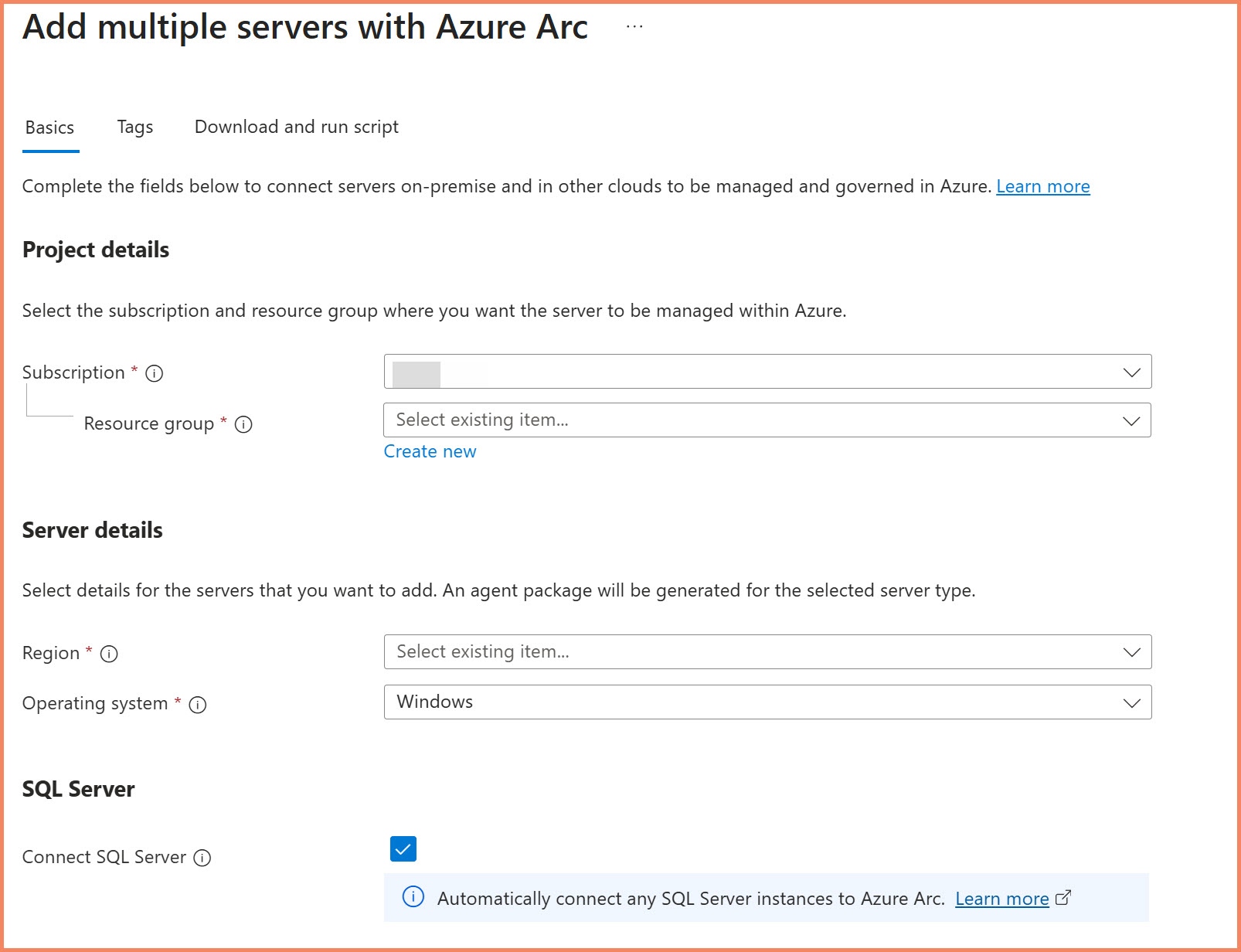
Azure portal Arc server onboarding: Generate script interface with subscription and resource group selection
Running the Onboarding Script
The generated script handles agent download, installation, and registration automatically:
$global:scriptPath = $myinvocation.mycommand.definition
function Restart-AsAdmin {
$pwshCommand = "powershell"
if ($PSVersionTable.PSVersion.Major -ge 6) {
$pwshCommand = "pwsh"
}
try {
Write-Host "This script requires administrator permissions to install the Azure Connected Machine Agent. Attempting to restart script with elevated permissions..."
$arguments = "-NoExit -Command `"& '$scriptPath'`""
Start-Process $pwshCommand -Verb runAs -ArgumentList $arguments
exit 0
} catch {
throw "Failed to elevate permissions. Please run this script as Administrator."
}
}
try {
if (-not ([Security.Principal.WindowsPrincipal] [Security.Principal.WindowsIdentity]::GetCurrent()).IsInRole([Security.Principal.WindowsBuiltInRole]::Administrator)) {
if ([System.Environment]::UserInteractive) {
Restart-AsAdmin
} else {
throw "This script requires administrator permissions to install the Azure Connected Machine Agent. Please run this script as Administrator."
}
}
# Add the service principal application ID and secret here
$ServicePrincipalId="your-service-principal-id";
$ServicePrincipalClientSecret="";
$env:SUBSCRIPTION_ID = "your-subscription-id";
$env:RESOURCE_GROUP = "your-resource-group";
$env:TENANT_ID = "your-tenant-id";
$env:LOCATION = "westeurope";
$env:AUTH_TYPE = "principal";
$env:CORRELATION_ID = "your-correlation-id";
$env:CLOUD = "AzureCloud";
[Net.ServicePointManager]::SecurityProtocol = [Net.ServicePointManager]::SecurityProtocol -bor 3072;
$azcmagentPath = Join-Path $env:SystemRoot "AzureConnectedMachineAgent"
if (-Not (Test-Path -Path $azcmagentPath)) {
New-Item -Path $azcmagentPath -ItemType Directory
Write-Output "Directory '$azcmagentPath' created"
}
$tempPath = Join-Path $azcmagentPath "temp"
if (-Not (Test-Path -Path $tempPath)) {
New-Item -Path $tempPath -ItemType Directory
Write-Output "Directory '$tempPath' created"
}
$installScriptPath = Join-Path $tempPath "install_windows_azcmagent.ps1"
# Download the installation package
Invoke-WebRequest -UseBasicParsing -Uri "https://gbl.his.arc.azure.com/azcmagent-windows" -TimeoutSec 30 -OutFile "$installScriptPath";
# Install the hybrid agent
& "$installScriptPath";
if ($LASTEXITCODE -ne 0) { exit 1; }
Start-Sleep -Seconds 5;
# Run connect command
& "$env:ProgramW6432\AzureConnectedMachineAgent\azcmagent.exe" connect --service-principal-id "$ServicePrincipalId" --service-principal-secret "$ServicePrincipalClientSecret" --resource-group "$env:RESOURCE_GROUP" --tenant-id "$env:TENANT_ID" --location "$env:LOCATION" --subscription-id "$env:SUBSCRIPTION_ID" --cloud "$env:CLOUD" --correlation-id "$env:CORRELATION_ID";
}
catch {
$logBody = @{subscriptionId="$env:SUBSCRIPTION_ID";resourceGroup="$env:RESOURCE_GROUP";tenantId="$env:TENANT_ID";location="$env:LOCATION";correlationId="$env:CORRELATION_ID";authType="$env:AUTH_TYPE";operation="onboarding";messageType=$_.FullyQualifiedErrorId;message="$_";};
Invoke-WebRequest -UseBasicParsing -Uri "https://gbl.his.arc.azure.com/log" -Method "PUT" -Body ($logBody | ConvertTo-Json) | out-null;
Write-Host -ForegroundColor red $_.Exception;
}
Critical: The service principal only needs "Azure Connected Machine Onboarding" role - don't over-delegate permissions! The portal gives you the script template with SP ID, but you add the secret manually before running it.
Local Agent Security Controls
Starting with Azure Arc agent version 1.16, you can implement enhanced security controls directly on the agent for environments requiring additional security hardening.
Agent Configuration Mode
By default, the Azure Arc agent runs in "full mode," which enables all extensions and functionalities including guest configuration, remote connectivity tools, and complete extension management. For environments requiring enhanced security, you can switch the agent to "monitor mode":
# Switch to monitor mode (monitoring extensions only) azcmagent config set config.mode monitor # View current agent configuration azcmagent config get # Return to full mode if needed azcmagent config set config.mode full
Monitor mode restricts the agent to only monitoring-related extensions and disables guest configuration services, providing a more secure but limited operational scope.
Extension Control
Configure which extensions can be installed on servers to prevent installation of unauthorized or arbitrary scripts. This is essential for managing extensions in privileged contexts:
# Configure extension allowlist (only these extensions can be installed) azcmagent config set extensions.allowlist "Microsoft.Azure.Monitor.AzureMonitorLinuxAgent,Microsoft.Azure.Security.Monitoring.AzureSecurityLinuxAgent" # Configure extension blocklist (these extensions cannot be installed) azcmagent config set extensions.blocklist "Microsoft.CPlat.Core.RunCommandLinux" # Disable extension manager entirely (maximum security) azcmagent config set extensions.enabled false # View current extension configuration azcmagent config get extensions
Guest Configuration Management
Azure Policy Guest Configuration can be disabled for strict control requirements:
# Disable Guest Configuration azcmagent config set guestconfiguration.enabled false # Enable Guest Configuration azcmagent config set guestconfiguration.enabled true
- Use extension allowlists rather than complete disabling for granular control
- Only local administrators can modify agent configuration settings
- Disable Guest Configuration only if policy compliance is not required
- Regularly audit agent configurations across your environment
Verification Steps
After running the script, verify successful onboarding:
- Check Azure portal: Server appears in Azure Arc → Servers
- Verify agent status: Run
azcmagent showon the server - Test connectivity: Agent status shows "Connected"
- Check extensions: Extensions pane is accessible in portal
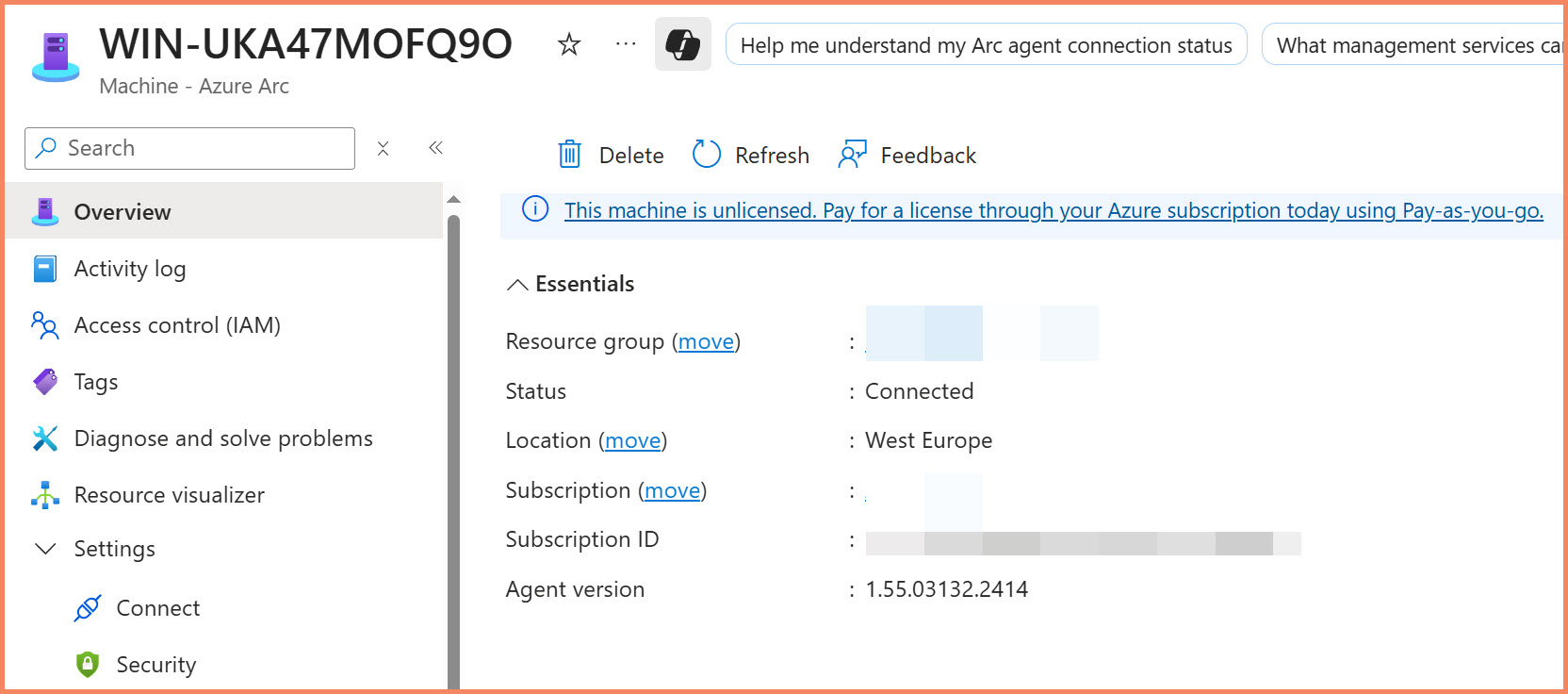
Successfully onboarded Arc server appearing in Azure portal with "Connected" status
# Check agent configuration and status azcmagent show # Test connectivity to Azure Arc azcmagent check # View installed extensions (should be empty initially) azcmagent extension list
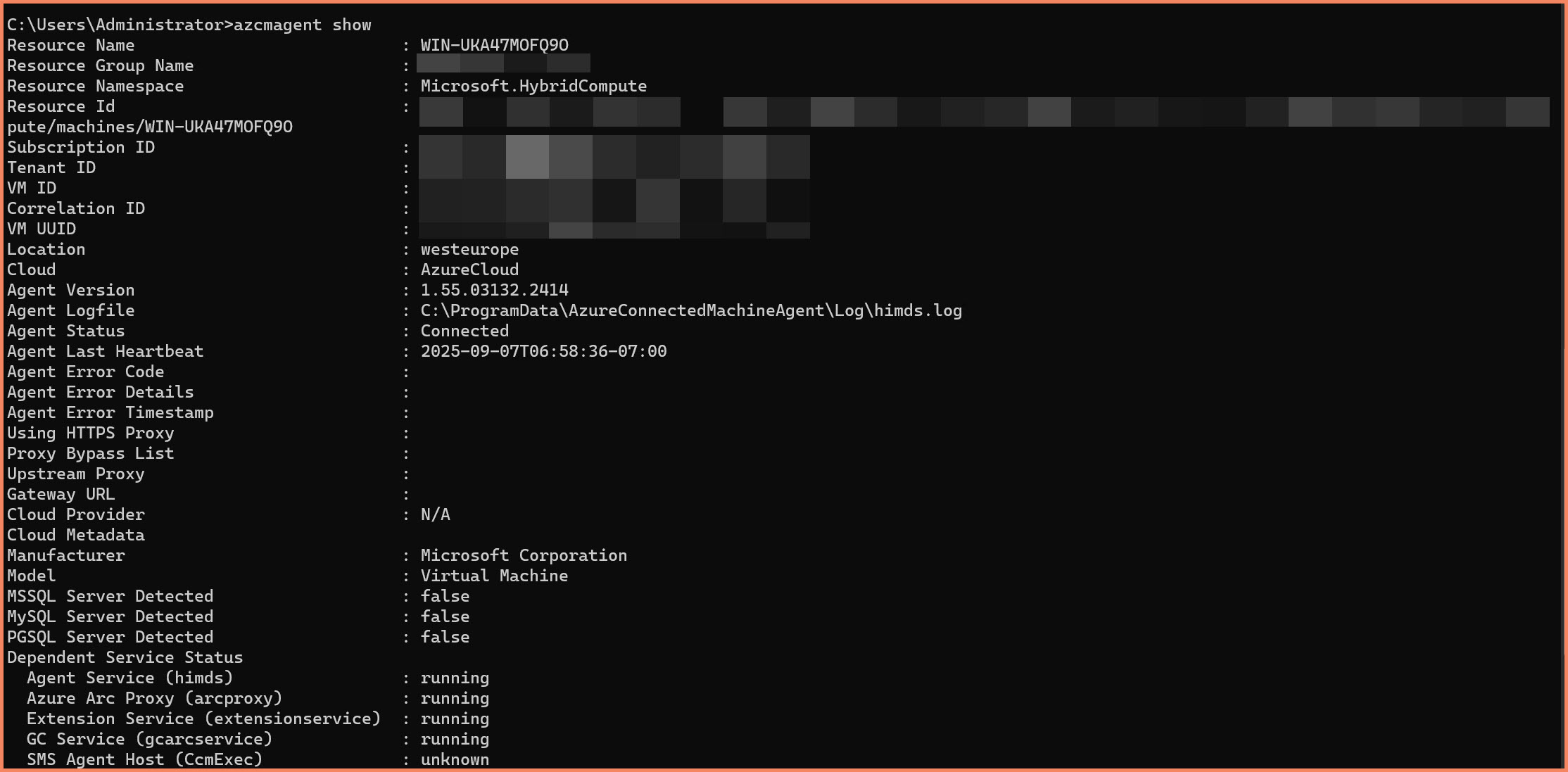
azcmagent show command output displaying successful connection details and agent configuration
What's Next: Once you've successfully onboarded a test server, you can experiment with extensions, policies, and monitoring capabilities. For production deployments, continue to the Technical Requirements and Deployment Methods sections.
Technical Requirements and Dependencies
Before implementing Arc at scale, understand the platform requirements, network dependencies, and architectural prerequisites. This section provides the technical foundation for planning your deployment.
Platform Support Matrix
| Platform | Supported Versions | Required Updates | Special Notes |
|---|---|---|---|
| Windows Server 2025 | All editions | Latest cumulative updates | Native Arc support |
| Windows Server 2022 | All editions including Server Core | KB5025230 or later | Full feature support |
| Windows Server 2019 | All editions | KB5025229 or later | Full feature support |
| Windows Server 2016 | All editions | Defender for Down-Level Devices | Limited extension support |
| Windows Server 2012 R2 | All editions | Defender for Down-Level Devices | Limited extension support |
| Ubuntu | 18.04, 20.04, 22.04, 24.04 LTS | Latest packages | systemd required |
| RHEL / CentOS | 7, 8, 9 | Latest updates | systemd required |
Required Azure Resource Providers
Your subscription must have these resource providers registered before onboarding Arc servers:
| Resource Provider | Purpose | Required |
|---|---|---|
Microsoft.HybridCompute |
Core Arc for Servers functionality | ✅ Always |
Microsoft.GuestConfiguration |
Azure Policy and configuration management | ✅ Always |
Microsoft.HybridConnectivity |
SSH/WinRM connectivity features | ✅ Recommended |
Microsoft.AzureArcData |
Arc-enabled SQL Servers | 🟡 If using Arc SQL |
Microsoft.Compute |
Azure Update Manager and automatic extension upgrades | ✅ Recommended |
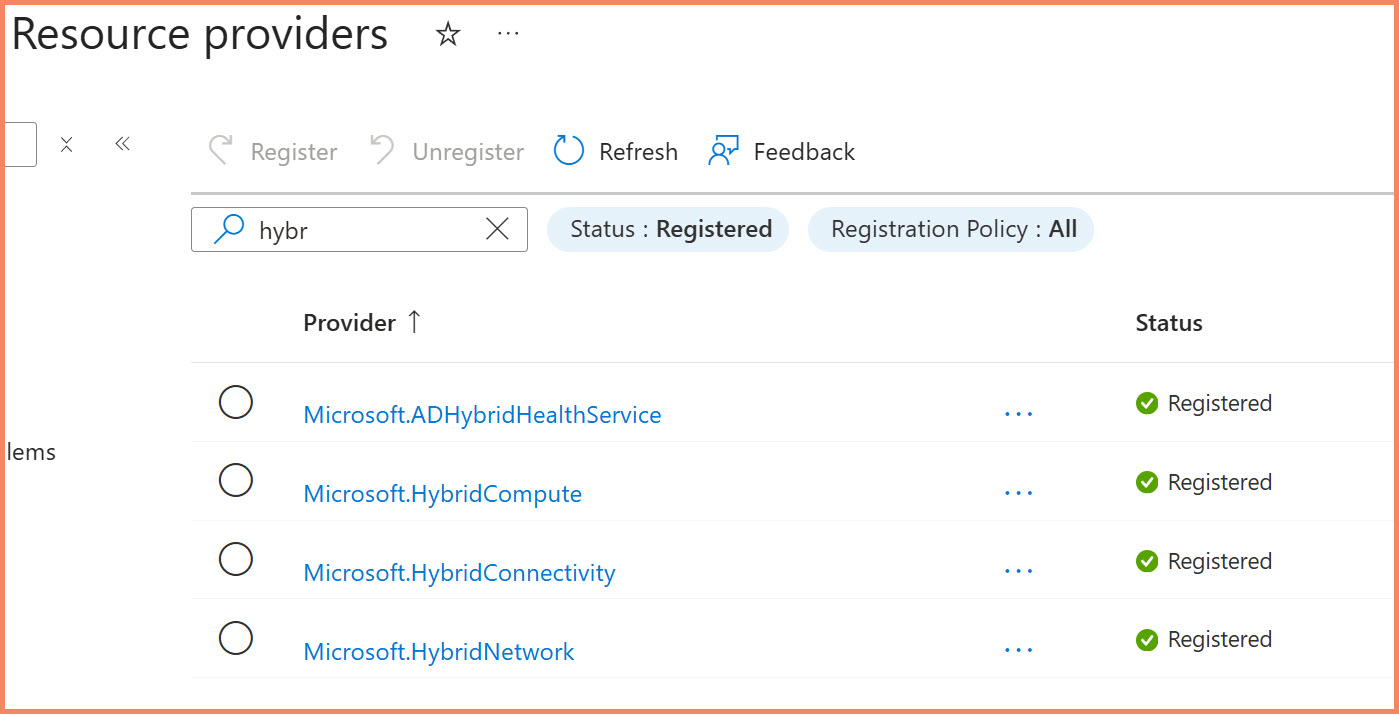
Azure portal: Resource provider registration status showing Microsoft.HybridCompute and related providers
Network Connectivity Requirements
Arc servers need connectivity to specific Azure endpoints. Network configuration often requires significant planning time.
Don't underestimate network planning - it's often the biggest implementation blocker.
Agent Connectivity Methods
| Method | Implementation | Complexity | Best For |
|---|---|---|---|
| Direct Internet | Servers connect directly to Azure endpoints | 🟢 Low | Cloud VMs, internet-connected servers |
| Proxy Server | Route through existing proxy infrastructure | 🟡 Medium | Corporate environments with established proxies |
| Arc Gateway | Deploy gateway appliance for regional connectivity | 🟠 High | Disconnected environments, multiple sites |
| Private Link | Private connectivity using Azure Private Link | 🔴 Very High | Highly secure environments, no internet egress |
Reference: For detailed connectivity guidance, see Microsoft's Arc connectivity documentation.
Deployment Methods and Enterprise Automation
Moving from testing to production requires choosing the right deployment method for your environment. This section covers enterprise-grade approaches that scale beyond individual servers.
Deployment Methods Comparison
| Method | Scale | Automation | Control Level | Best For |
|---|---|---|---|---|
| Configuration Manager | 🟢 100+ servers | 🟢 High | 🟢 Very High | Enterprise SCCM environments |
| PowerShell Remoting | 🟡 50-200 servers | 🟢 High | 🟡 Medium | PowerShell-capable environments |
| Group Policy | 🟢 Domain-wide | 🔴 Low | 🔴 Low | AD-integrated (slower rollout, limited control) |
Service Principal Setup for Production
Service principals provide secure, scalable authentication for Arc deployments without exposing user credentials:
# Connect to Microsoft Graph for Entra ID operations
Connect-MgGraph -Scopes "Application.ReadWrite.All"
# Connect to Azure for RBAC assignment
Connect-AzAccount
# Create the service principal
$appParams = @{
DisplayName = "Arc-Onboarding-ServicePrincipal"
Description = "Service Principal for Azure Arc server onboarding"
}
$app = New-MgApplication @appParams
# Create service principal for the application
$sp = New-MgServicePrincipal -AppId $app.AppId
# Create a client secret (valid for 2 years)
$passwordCred = @{
displayName = "Arc-Onboarding-Secret"
endDateTime = (Get-Date).AddYears(2)
}
$secret = Add-MgApplicationPassword -ApplicationId $app.Id -PasswordCredential $passwordCred
# Assign Azure Connected Machine Onboarding role
# Replace with your subscription ID and scope (subscription, resource group, etc.)
$subscriptionId = "your-subscription-id"
$scope = "/subscriptions/$subscriptionId" # or "/subscriptions/$subscriptionId/resourceGroups/your-rg"
New-AzRoleAssignment `
-ObjectId $sp.Id `
-RoleDefinitionName "Azure Connected Machine Onboarding" `
-Scope $scope
# Output the details you need for onboarding script
Write-Host "Service Principal Details:" -ForegroundColor Green
Write-Host "Application ID: $($app.AppId)" -ForegroundColor Yellow
Write-Host "Secret Value: $($secret.SecretText)" -ForegroundColor Yellow
Write-Host "Tenant ID: $((Get-MgContext).TenantId)" -ForegroundColor Yellow
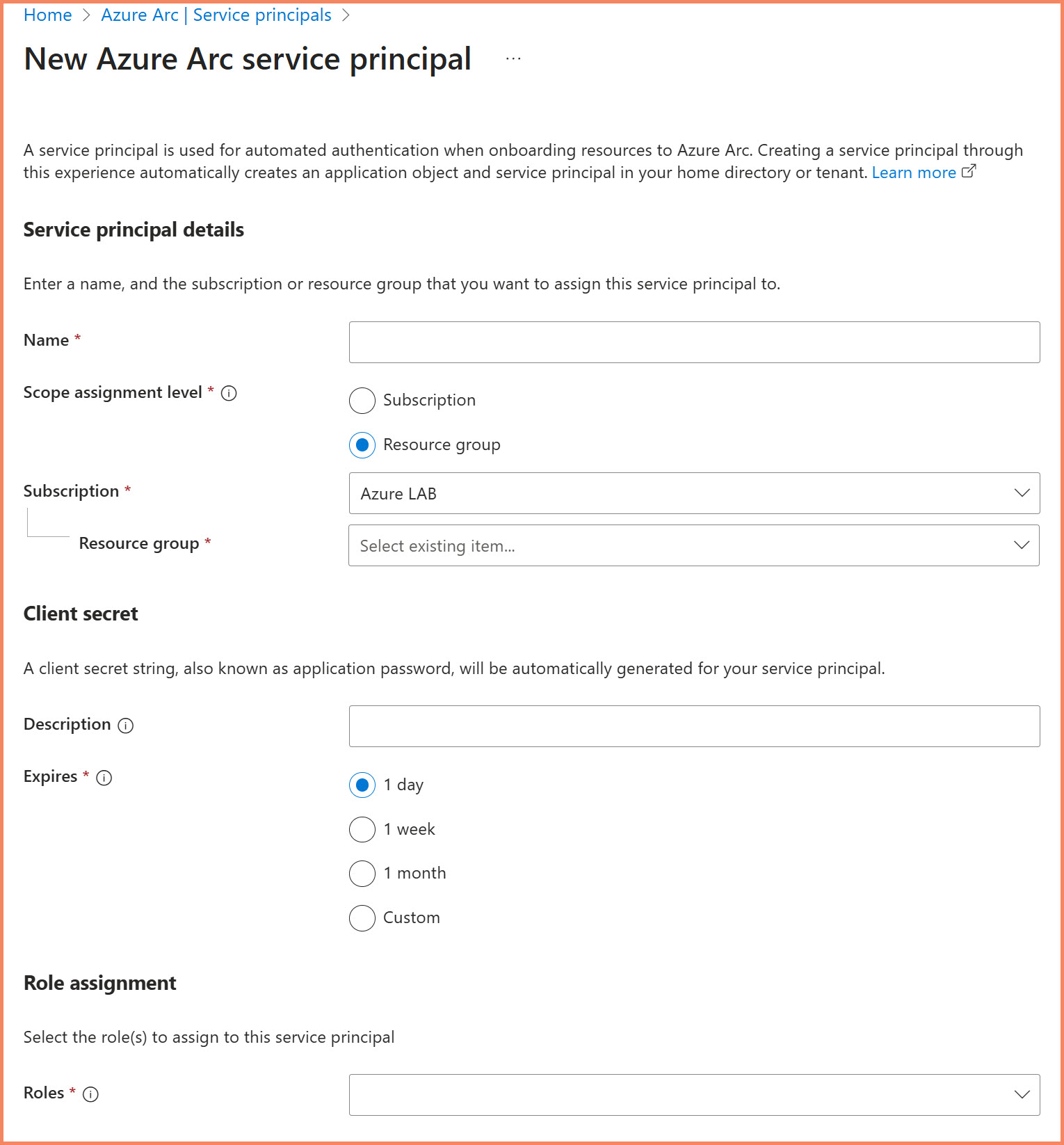
Creating dedicated service principal for Arc onboarding with minimal required permissions
Configuration Manager Integration (Enterprise Approach)
For organizations already running Configuration Manager (yes, I still call it SCCM sometimes! 😄), this is often the most logical Arc deployment method. People who complain that Configuration Manager is complex usually haven't done real device management in larger environments - when you're managing thousands of servers across multiple sites, geographic regions, and maintenance windows, you need that level of control and orchestration.
Configuration Manager provides excellent control for Arc deployment through custom task sequences, offering enterprise-grade deployment management capabilities that simple scripts can't match:
| SCCM Advantage | Capability | Arc Deployment Benefit |
|---|---|---|
| Phased Deployment | Dynamic device collections with deployment phases | Controlled rollout with success validation |
| Maintenance Windows | Scheduled installation during approved hours | Minimize business disruption |
| Prerequisites Handling | Pre-flight checks, updates, reboots | Ensure Arc prerequisites are met |
| Reporting & Compliance | Detailed success/failure tracking | Complete deployment visibility |
| Conditional Logic | OS-specific task sequences | Handle Windows/Linux variations |
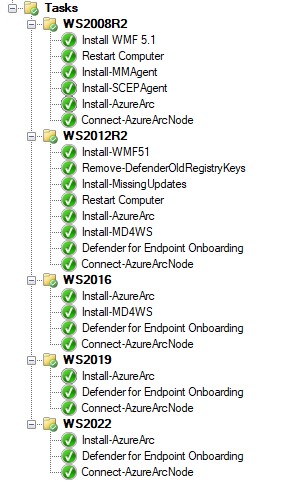
SCCM task sequence for Arc deployment: conditional steps, OS detection, and phased rollout configuration
PowerShell Remoting Approach
If you have PowerShell remoting enabled, then you can download the Microsoft official PowerShell module from the PowerShell Gallery and onboard all the machines remotely! If you are not using PowerShell remoting today, then it is time to ditch the RDP :)
# Install the Az.ConnectedMachine PowerShell module
Install-Module -Name Az.ConnectedMachine -Verbose -Force
# Connect to Azure and set context
Connect-AzAccount
Set-AzContext -SubscriptionId "your-subscription-id"
# Onboard remote machine using PowerShell Remoting
$ServerName = "SERVER02"
$PSRemoteSession = New-PSSession -ComputerName $ServerName
$OnboardingDetails = @{
ResourceGroupName = "RG-PROD-IT-ARC"
Location = "West Europe"
PSSession = $PSRemoteSession
}
Connect-AzConnectedMachine @OnboardingDetails
The Az.ConnectedMachine PowerShell module provides an official Microsoft approach for Arc onboarding. You can create multiple remote sessions against many machines and onboard them simultaneously. This method works well for PowerShell-capable environments where you have remote access to target servers.
Dynamic Tagging and Resource Organization
My recommendation is to set up automated tagging that triggers after Arc onboarding through Azure eventing and provisioning automation. As I mentioned in the design section, resource tagging is important for operational efficiency. This approach gives you extra use cases - when a node gets onboarded, automation kicks in to automatically apply tags based on data sources like CMDB, Defender for Endpoint, ServiceNow, or whatever systems you're working with. These tags can also be used for Microsoft Defender XDR Security Settings Management enrollment targeting.
Option 1: Pre-onboarding enrichment - Gather data and apply tags during the onboarding script execution
Option 2: Post-onboarding automation - Use Azure Event Grid and Logic Apps/Functions to tag after onboarding completes
Pre-Onboarding Discovery (Option 1)
You can discover and gather all the necessary data first, then connect the server to Arc with tags already applied. This approach reduces post-onboarding automation complexity but requires the onboarding script to handle data discovery upfront.
Event-Driven Tag Assignment (Option 2)
When an Arc server is onboarded, automation triggers queries to multiple data sources simultaneously. The CMDB provides department and application information, Defender XDR supplies security risk levels, ServiceNow offers ownership details, and custom APIs deliver business-specific data.
Automated Tag Building
All collected data gets consolidated into a comprehensive tag set that includes security tier classification, maintenance windows, cost center allocation, and operational metadata. This happens automatically without manual intervention.
Reference: For complete deployment options and detailed procedures, see Microsoft's Arc deployment documentation.
Troubleshooting and Operations
When Arc deployments fail or agents disconnect, quick diagnosis and resolution are critical. This section provides practical troubleshooting guidance based on real-world operational experience.
Common Issues and Resolutions
| Problem | Symptoms | Most Likely Cause | Resolution Steps |
|---|---|---|---|
| Onboarding Fails | Script completes but server doesn't appear in portal | Network connectivity to Azure endpoints | Check firewall rules, proxy settings, DNS resolution |
| Agent Shows Disconnected | Server appears but status is "Disconnected" | Network changes, expired certificates | Run azcmagent check, restart agent service |
| Extensions Fail to Install | Extension deployment shows "Failed" status | Insufficient permissions, PowerShell constraints | Check PowerShell execution policy and constraint mode |
| Policy Application Fails | Azure policies show non-compliant status | RBAC permissions, agent version compatibility | Verify permissions, update agent to latest version |
Diagnostic Commands Reference
Essential commands for diagnosing Arc agent issues:
# Check agent status and configuration azcmagent show # Test connectivity to Azure Arc endpoints azcmagent check # List installed extensions azcmagent extension list # Check agent version azcmagent --version # View agent logs location azcmagent logs

azcmagent check command output showing connectivity test results and potential network issues
Arc Agent Log Analysis
Arc agents write diagnostic information to log files that can be collected and analyzed for troubleshooting. The azcmagent logs command provides an easy way to gather all relevant log files.
- Windows Arc Agent:
%ProgramData%\AzureConnectedMachineAgent\Log\azcmagent.log - Linux Arc Agent:
/var/opt/azcmagent/log/azcmagent.log - Windows Extensions & Policies:
C:\ProgramData\GuestConfig\arc_policy_logs\- Azure Policy compliance logsextension_logs\- Extension-specific logs (e.g., Microsoft.Azure.Monitor.AzureMonitorWindowsAgent)ext_mgr_logs\- Extension manager logsextension_reports\- Extension execution reports
# Collect recent log files to current directory azcmagent logs # Collect all log files to specific location azcmagent logs --full --output "C:\temp\arc-logs.zip" # Enable verbose logging for troubleshooting (Windows) & "$env:ProgramFiles\AzureConnectedMachineAgent\azcmagent.exe" connect --verbose # View live log file (Windows) Get-Content "%ProgramData%\AzureConnectedMachineAgent\Log\azcmagent.log" -Wait # View live log file (Linux) tail -f /var/opt/azcmagent/log/azcmagent.log
- AZCM0026: Network connectivity issues - check firewall/proxy settings
- AZCM0041: Authentication failed - verify service principal credentials
- AZCM0042: Resource creation failed - check Azure RBAC permissions
- AZCM0147-0152: Windows installation errors - check system requirements
Reference: Complete error code list at Microsoft's Arc troubleshooting guide
Network Connectivity Troubleshooting
Network issues are the most common cause of Arc problems. Systematic network testing is needed:
# Use the Arc agent's built-in network connectivity test azcmagent check --location "westeurope" # This tests all required Arc endpoints automatically: # - Azure Resource Manager endpoints # - Azure Active Directory endpoints # - Telemetry endpoints # - Guest configuration endpoints # - Extension management endpoints # For detailed output with specific endpoint results azcmagent check --location "westeurope" --verbose # Check connectivity with private endpoints enabled azcmagent check --location "westeurope" --enable-pls-check # Check connectivity including all extension endpoints azcmagent check --extensions all
Agent Service Management
Sometimes restarting services resolves connectivity or performance issues:
# Check Arc service status Get-Service -Name "himds" | Format-List # Restart Arc agent service Restart-Service -Name "himds" -Force # Check Guest Configuration service Get-Service -Name "GCArcService" | Format-List # View service dependencies Get-Service -Name "himds" -DependentServices
Use
azcmagent disconnect followed by agent uninstallation before attempting fresh installation.
Resource Cleanup and Maintenance
Operational hygiene prevents many issues before they occur:
- Monitor agent connectivity - Implement alerting for disconnected agents
- Keep agents updated - Enable automatic updates and monitor agent versions
- Clean up decommissioned servers - Remove Arc registration when servers are retired
- Regular health checks - Run
azcmagent checkperiodically across your fleet - Document troubleshooting procedures - Create runbooks for common issues
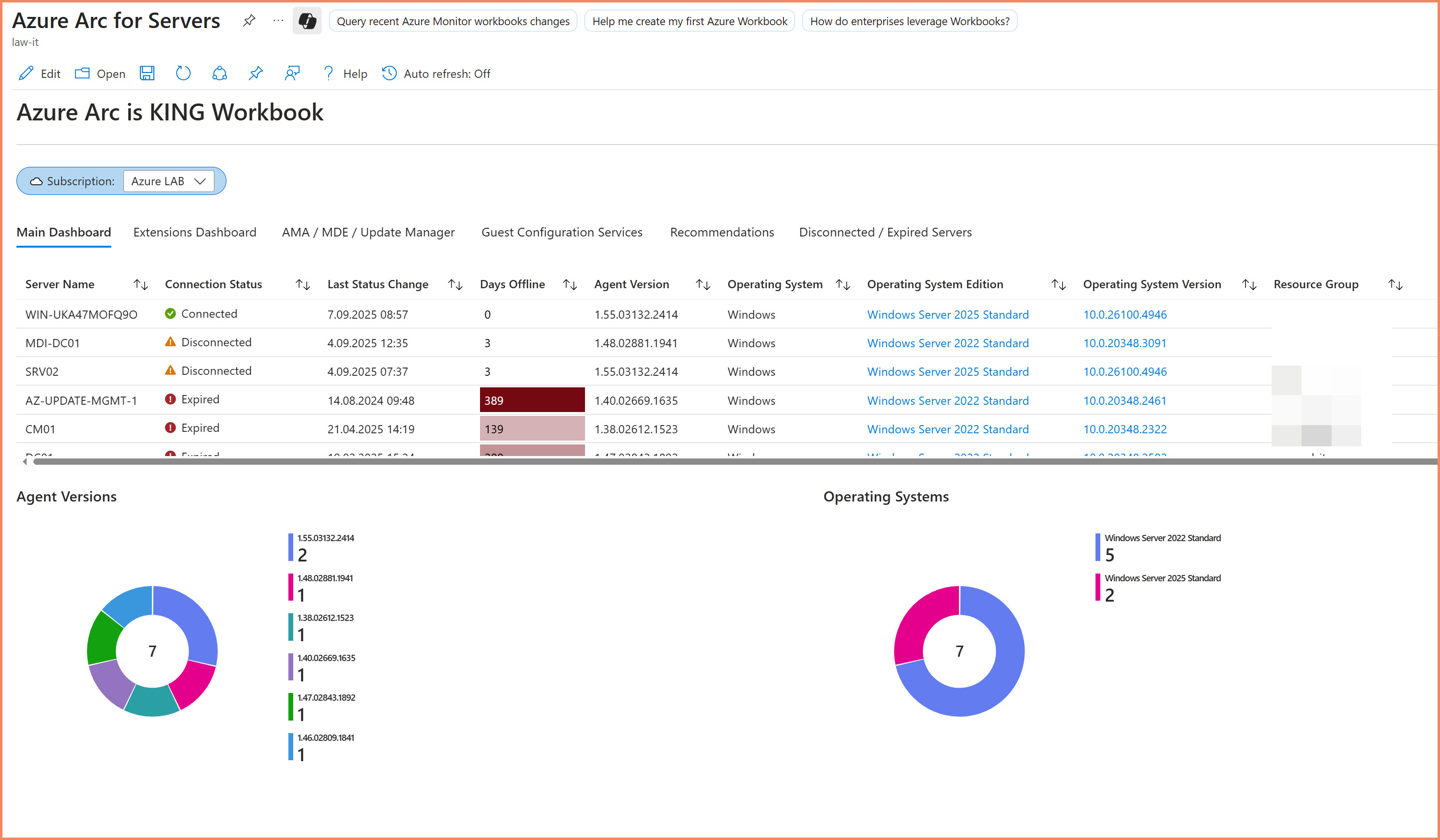
Azure dashboard showing Arc server fleet health: connectivity status, agent versions, and operational alerts
Strategic Implementation Success: Beyond Agent Installation
Azure Arc for Servers represents one of Microsoft's most significant infrastructure innovations, but successful implementation requires far more than just installing agents on servers. This is a strategic transformation that touches security architecture, administrative models, network design, and operational processes.
Key Strategic Considerations
Throughout this guide, we've emphasized that Azure Arc success depends on understanding these critical elements:
- Security Architecture First - Proper RBAC design, service principal strategy, and permission inheritance planning
- Network Architecture - Connectivity method selection, endpoint planning, and proxy/firewall considerations
- Administrative Model Design - Integration between on-premises AD and Entra ID with proper tier separation
- Deployment Strategy - Enterprise-grade automation using service principals, not manual portal scripts
- Operational Excellence - Monitoring, maintenance, troubleshooting procedures, and resource lifecycle management
The Transformation Challenge
Moving from the simple MMA architecture to Azure Arc's distributed building blocks requires architectural thinking. Organizations that treat this as "just another agent installation" typically struggle with:
- Security boundaries becoming blurred when domain admins suddenly have cloud management capabilities
- Network complexity underestimated, leading to connectivity failures and performance issues
- Operational gaps where no one knows how to troubleshoot or maintain the new hybrid architecture
- Scale limitations when testing approaches don't translate to enterprise production requirements
The Enterprise Success Formula
Based on real-world implementations across multiple enterprise environments, successful Azure Arc transformations follow this pattern:
| Phase | Focus Area | Key Deliverables | Success Criteria |
|---|---|---|---|
| Assessment | Current state analysis | Infrastructure inventory, security model review | Clear understanding of transformation scope |
| Architecture | Target state design | Security architecture, network design, operational model | Comprehensive implementation blueprint |
| Implementation | Controlled deployment | Pilot validation, phased rollout, automation framework | Production-ready Arc environment |
| Operations | Ongoing management | Monitoring, maintenance procedures, troubleshooting runbooks | Self-sufficient operational capability |
When Professional Services Make Sense
Azure Arc implementations benefit from professional services when you need to:
- Accelerate time-to-value - Avoid common pitfalls and implementation delays
- Ensure architectural soundness - Proper security boundaries and operational design
- Transfer knowledge effectively - Build internal capability for ongoing management
- Integrate with existing systems - SCCM, monitoring tools, security solutions
- Scale beyond proof-of-concept - Enterprise-grade automation and procedures
Ready to Transform Your Infrastructure?
Azure Arc for Servers isn't just a technology decision - it's a strategic transformation that requires careful planning, expert architecture, and proven implementation methods. Don't let your organization struggle with common pitfalls or settle for suboptimal implementations.
Assessment & Strategy: Current state analysis, transformation roadmap, business case development
Architecture & Design: Security model design, network architecture, integration planning with existing systems
Implementation & Automation: Enterprise deployment, custom tooling development, phased rollout management
Knowledge Transfer & Support: Team training, operational procedures, ongoing advisory support
Azure Arc Enablement Services
From assessment to implementation, I help organizations successfully transform their infrastructure with Azure Arc. Get expert guidance, proven methodologies, and custom automation tools tailored to your environment.
Microsoft MVP since 2010 | 15+ years infrastructure experience | Enterprise Arc implementations across Europe
Why Choose Professional Azure Arc Services?
- Business alignment & ROI planning
- Risk assessment & mitigation
- Integration with existing systems
- Security-first design principles
- Scalable deployment frameworks
- Operational excellence patterns
"Transform your infrastructure strategically, not tactically. Get the architectural foundation right from the beginning."

